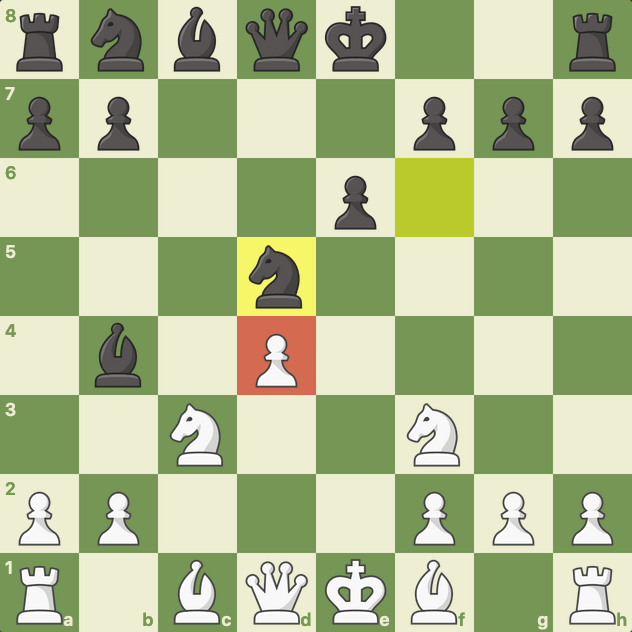
Isolated Queen's Pawn
The isolated queen's pawn is an important type of pawn to know. It is a vital concept that is featured in many different openings. Let's learn more about this type of pawn.
Here is what you need to know about isolated queen's pawns:
- What Is An Isolated Queen's Pawn?
- Why Is The Isolated Queen's Pawn Important?
- Openings That Have Isolated Queen's Pawns
- Conclusion
What Is An Isolated Queen's Pawn?
The isolated queen's pawn (also known as an IQP or isolani) refers to an isolated pawn on the d-file. Isolated queen's pawns cannot be protected or supported by another pawn, and they are never part of a pawn chain because the pawns on adjacent files (in this case the pawns on the e-file and c-file) no longer exist. Here is a position where White has an IQP on the d4-square:

As you can see, the IQP on d4 cannot be supported by another pawn, and it is not part of a pawn chain. Here is another example of an isolated queen's pawn position that occurs in the mainline of the Tarrasch Defense after 1.d4 d5 2.c4 e6 3.Nf3 Nf6 4.g3 c5 5.cxd5 exd5 6.Bg2 Nc6 7.Nc3 Be7 8.0-0 0-0 9.dxc5 Bxc5:

In the above position, it is Black who as an isolated queen's pawn. Just like in the first diagram, this d5-pawn is isolated and can't be protected by another pawn.
It is worth noting that just because a player has an isolated queen's pawn does not mean that their position is automatically worse. The above position also illustrates that in exchange for accepting the structural weakness in the form of an IQP, Black has easy development, natural squares to place his pieces, and no bad pieces.
Why Is The Isolated Queen's Pawn Important?
Isolated queen's pawns are important because they are seen in many openings, they are an important feature in any position that has them, and they offer rich possibilities in the middlegame for both sides. Some players prefer playing with IQPs, while others prefer to play against IQPs.
Players who enjoy playing with isolated queen's pawns like the potential positives that they bring. In general, the side with an isolated queen's pawn has more space and greater attacking chances.
In the following position from the game between former world champion GM Vladimir Kramnik and GM Robert Huebner in 2000, we can see that White has an excellent IQP position with nice attacking chances after 13.Qd3:

White has a noticeable space advantage, and the battery created by the light-squared bishop and queen aimed at the black king is unpleasant to deal with. Kramnik won this game just 14 moves later:
As mentioned, some players prefer playing against IQPs. When playing against the isolated queen's pawn, the goal should be to blockade the pawn, attack the pawn, and ultimately win it. In game four of the 1996 world championship match between GM Gata Kamsky and GM Anatoly Karpov, that is exactly what Karpov did. Here is the position after Karpov's 21...Bd5:

In the position above, Black has done a great job of blockading the isolated pawn and attacking it. It is worth noting that as more pieces get exchanged, the defense of an IQP can become more difficult as there are fewer pieces to protect the pawn. In the game, Karpov was able to eventually win the isolated queen's pawn and the game:
Whether you enjoy playing positions with isolated queen's pawns, against isolated queen's pawns, or both, it is clear that IQP positions are incredibly important to understand. Let's take a look at some openings that feature an isolated queen's pawn.
Openings That Have Isolated Queen's Pawns
As mentioned, there is an ample abundance of openings that lead to positions where IQPs are featured. Many queen's pawn openings like the Queen's Gambit, the Nimzo-Indian Defense, the Tarrasch Defense, and more feature an IQP.
However, it is not queen's pawn openings alone that feature an isolani—many king's pawn openings can lead to IQP positions as well, including the Sicilian Defense, Caro-Kann Defense, French Defense, and more. Let's take a look at some of these openings and how they can turn into positions with IQPs.
In the Tarrasch Variation of the French Defense, Black has an IQP after the moves 1.e4 e6 2.d4 d5 3.Nd2 c5 4.exd5 exd5 5.Ngf3 Nc6 6.Bb5 Bd6 7.dxc5 Bxc5:

In the Panov-Botvinnik Variation of the Caro-Kann Defense, White has an isolated queen's pawn after the moves 1.e4 c6 2.d4 d5 3. exd5 cxd5 4.c4 Nf6 5.Nc3 e6 6.Nf3 Bb4 7.cxd5 Nxd5:

Let's take a look at one final example of a king's pawn opening that can include an isolated queen's pawn. In the Alapin Variation of the Sicilian Defense, White has an isolated queen's pawn after the moves 1.e4 c5 2.c3 d5 3.exd5 Qxd5 4.d4 Nf6 5.Nf3 Bg4 6.Be2 e6 7.h3 Bh5 8. 0-0 cxd4 9.cxd4:

As you can see, it doesn't matter what openings you play—isolated queen's pawns can occur in almost any opening repertoire.
Conclusion
You now know what isolated queen's pawns are, why they are important, some openings that feature them, and more! Check out this great Chess.com Lesson, this article by IM Jeremy Silman, or this article by GM Bryan Smith for more information on the isolated queen's pawn.







